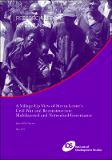| dc.contributor.author | Vincent, James B. M. | |
| dc.coverage.spatial | Sierra Leone | en_GB |
| dc.date.accessioned | 2014-08-13T15:26:31Z | |
| dc.date.available | 2014-08-13T15:26:31Z | |
| dc.date.issued | 2012-05-14 | |
| dc.identifier.citation | Vincent, J. B. M. (2012) A Village-Up View of Sierra Leone’s Civil War and Reconstruction: Multilayered and Networked Governance. IDS Research Report 75, IDS: Brighton | en_GB |
| dc.identifier.issn | 978 1 78118 050 1 | |
| dc.identifier.uri | https://opendocs.ids.ac.uk/opendocs/handle/20.500.12413/4269 | |
| dc.description.abstract | Sierra Leone not only has a direct relationship with its citizens as individuals but also a mediated one through the rural governance systems that pre-dated colonialism and often have greater legitimacy than the central state itself. The impact of the civil war in the rural areas was devastating. Nonetheless the pre-war (traditional) leadership structures continued informally to provide whatever degree of governance response was possible. In the 38 communities visited throughout rural Sierra Leone, a third of the chiefs remained with their people (even if in hiding) throughout even the most difficult part of the civil war and most of the rest fled only briefly. During the war chiefs made a major change to include youth and women in their governance practices and this more participatory approach to governance has persisted. Although a large number of chiefs died during the war period, their positions were easily refilled afterward.
During the war most communities in the South and East created local Civilommunity Defensce Forces (CDF) to defend themselves. Chiefs retained at least some degree of direction over 71% per cent of the CDF forces in the areas visited, with the consequence that only a third of these CDFs gave trouble to their communities.
The role of international donors increased significantly as a result of the war as well. Nonetheless, their initiatives have strengthened, not threatened the legitimacy of the state because the army, police and health services have improved and as local citizens do not know how to access the donors directly they tend to credit their activities to various government actors.
The various reforms that have come in the wake of the civil war are incomplete and the institutional boundaries of the newly reconstructed multi-layered governance system are unclear. Not enough attention has been paid to governance at the ‘periphery’. | en_GB |
| dc.description.sponsorship | The report was produced under the auspices of the RCUK Global Uncertainties Programme on Security in an Africa of Networked, Multi-Level Governance. | en_GB |
| dc.language.iso | en | en_GB |
| dc.publisher | IDS | en_GB |
| dc.relation.ispartofseries | IDS Research Report;75 | |
| dc.rights | All rights reserved. Reproduction, copy, transmission, or translation of any part of this publication may be made only under the following conditions:
• with the prior permission of the publisher; or
• with a licence from the Copyright Licensing Agency Ltd., 90 Tottenham Court Road, London W1P 9HE, UK, or from another national licensing agency; or
• under the terms set out below.
This publication is copyright, but may be reproduced by any method without fee for teaching or nonprofit
purposes, but not for resale. Formal permission is required for all such uses, but normally will be granted immediately. For copying in any other circumstances, or for re-use in other publications, or for translation or adaptation, prior written permission must be obtained from the publisher and a fee may be payable. | en_GB |
| dc.rights.uri | http://www.ids.ac.uk/files/dmfile/IDSOpenDocsStandardTermsOfUse.pdf | en_GB |
| dc.subject | Governance | en_GB |
| dc.subject | Politics and Power | en_GB |
| dc.subject | Security and Conflict | en_GB |
| dc.title | A Village-Up View of Sierra Leone’s Civil War and Reconstruction: Multilayered and Networked Governance | en_GB |
| dc.type | IDS Research Report | en_GB |
| dc.rights.holder | IDS | en_GB |

